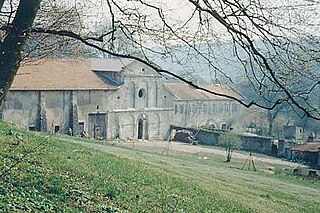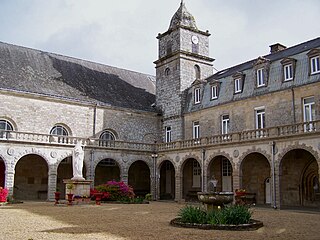
The Tironensian Order or the Order of Tiron was a medieval monastic order named after the location of the mother abbey in the woods of Thiron-Gardais in Perche, some 35 miles west of Chartres in France). They were popularly called "Grey Monks" because of their grey robes, which their spiritual cousins, the monks of Savigny, also wore.

Déols is a commune in the department of Indre, region of Centre-Val de Loire, central France.

La Cambre Abbey or Ter Kameren Abbey is a former Cistercian abbey in the City of Brussels, Belgium. It is located in the Maelbeek valley between the Bois de la Cambre/Ter Kamerenbos and the Ixelles Ponds. The abbey church is a Catholic parish of the Archdiocese of Mechelen–Brussels and home to a community of Norbertine canons, while other parts of the monastery house the headquarters of the Belgian National Geographic Institute (NGI) and La Cambre, a prestigious visual arts school.

Ouche Abbey or the Abbey of Saint-Evroul is a former Benedictine abbey in Normandy, located in the present commune of Saint-Évroult-Notre-Dame-du-Bois, Orne, Normandy. It has been classified as a Monument historique since 1967 and is designated "classé".

Saint-Martin-de-Boscherville is a commune in the Seine-Maritime department in the Normandy region in northern France.

Liège Cathedral, otherwise St. Paul's Cathedral, is a Roman Catholic cathedral in Liège, Belgium. Founded in the 10th century, it was rebuilt from the 13th to the 15th century and restored in the mid-19th century. It became a Catholic cathedral in the 19th century due to the destruction of Saint Lambert's Cathedral in 1795. It is the seat of the Diocese of Liège.

The Abbey of St. Mary of Lagrasse is a Romanesque abbey in Lagrasse, southern France, whose origins date to the 7th century. It is located in Languedoc, near the Corbières Massif, about 35 km from Carcassonne. It was originally a Benedictine monastery, but since 2004 has been home to a community of canons regular.

Moissac Abbey was a Benedictine and Cluniac monastery in Moissac, Tarn-et-Garonne in south-western France. A number of its medieval buildings survive, including the abbey church, which has a famous and important Romanesque sculpture around the entrance.

The Abbey of Our Lady of Ardenne, commonly called Ardenne Abbey, is a former Premonstratensian abbey founded in the 12th century and located near Saint-Germain-la-Blanche-Herbe in Calvados, near Caen, France. It is now occupied by the Institute of Contemporary Publishing Archives. Several buildings of the abbey have been preserved, including the church. These are protected as historic monuments.

St. James's Church is a Roman Catholic church located in the center of Liège, Belgium. Originally the abbey church of Saint James Abbey, founded in 1015 by Prince-Bishop Balderic II, successor of Notker, it later became Saint James's Collegiate Church, following the destruction of Saint Peter's Collegiate Church. After the Concordat of 1801, Saint James became a parish church. The main cloister of the abbey was transformed into a public park, and the abbey buildings were demolished.

Montivilliers Abbey is a former Benedictine nunnery, founded between 682 and 684 by Saint Philibert in the town of Montivilliers in Normandy, in the present department of Seine-Maritime, France. It was suppressed during the French Revolution, but many buildings, including the church, have survived.

Saint-Maur Abbey, originally called the Abbaye des Fossés, is a former abbey now subsumed in the Saint-Maur-des-Fossés suburb of Paris, France. The remains and the domain of the abbey have been transformed into a pleasure park named Parc de l'abbaye. The former abbey building has been replaced by a square at the corner of Avenue de Condé and Rue de l'Abbaye. Some ruins remain, such as the Rabelais tower, the 19th century Bourières villa and the old fortifications. The remains of the abbey have been classified as historical monuments since 13 June 1988.

Solignac Abbey, or the Abbey of Saint-Peter and Saint Paul of Solignac, is an abbey in Solignac, near Limoges, in Haute-Vienne. It was founded around 631 AD by Saint Eligius (Éloi). The present buildings date to the 12th century, but have been modified many times since then. The abbey was dissolved during the French Revolution and the buildings were put to new uses, including a prison, boarding school, porcelain factory and seminary. As of 2021 there were plans to restore it back to its original function as a monastery.

Menat Abbey is an abbey located in the village of Menat, Puy-de-Dôme, in the heart of the Sioule valley. It is one of the oldest monastic foundations in Auvergne.

The Collegiate Church of Saint-Barnard is a former collegiate church in Romans-sur-Isère, France, founded in 838 by Saint Bernard of Vienne on the banks of the Isère river.

The Abbey of Saint-Antoine was the mother abbey of the Hospital Brothers of Saint Anthony. It is located in Saint-Antoine-l'Abbaye, in the department of Isère, in France. It includes an abbey church and premises that once housed the monks' homes.

Antoine Le Roux was an abbot of Fécamp Abbey and Saint-Georges de Boscherville.

Sainte-Marie-au-Bois is a former abbey of the Premonstratensians order, located in the commune of Vilcey-sur-Trey, Meurthe-et-Moselle, France, built near a spring at the bottom of a small valley where a tributary of the Trey flows. Long considered the oldest settlement of the Premonstratensians order in Lorraine, its abbot in the early 17th century was Servais de Lairuelz, who led the reform of his order, first in Lorraine and then beyond. At the start of the First World War, French writer and poet Charles Péguy stayed at the former abbey, now a farm. Today, its remarkable remains make Sainte-Marie-au-Bois a rare architectural reminder of the Prémontré order in the 12th century.

Langonnet Abbey, formally the Abbey of Notre-Dame de Langonnet, which became the Langonnet stud farm between 1807 and 1857, is a former Cistercian abbey belonging to the diocese of Quimper. It is located in the Gourin deanery, east of the village of Langonnet, on the road to Plouray. It now belongs to the Congrégation du Saint-Esprit. It was listed as a monument historique by decree on September 25, 1928. Its ogival-style chapter house dates back to the 13th century.

The Abbey of Notre-Dame de La Couronne is a monastery of canons located at La Couronne in the Charente department of France. The abbey church, now in ruins, is a testament to the introduction of the Gothic style in western France.






















